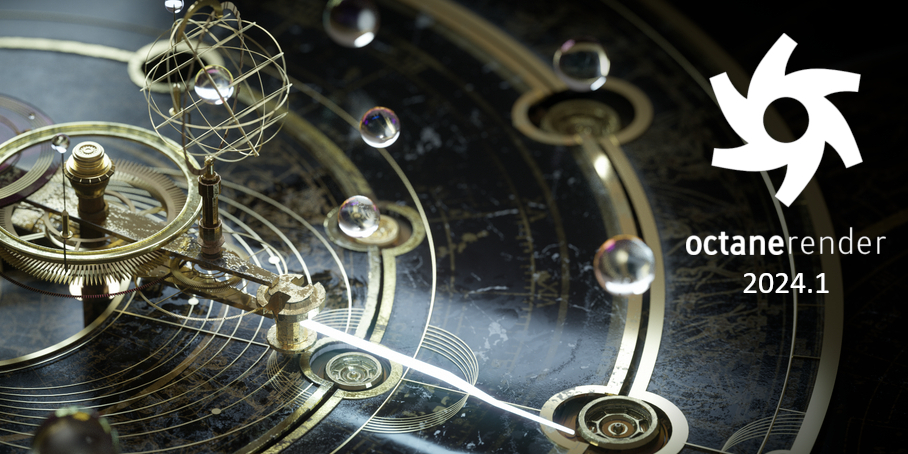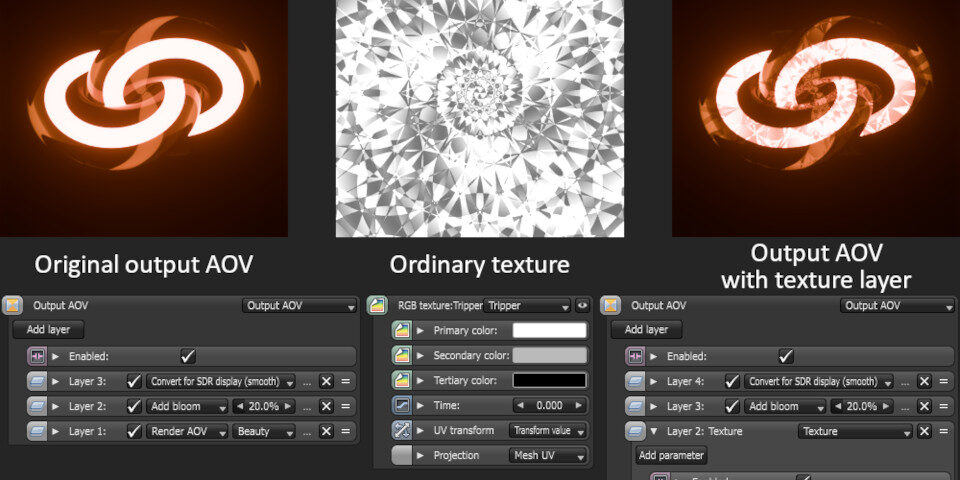Otoy releases OctaneRender 2024.1

Posted on 28 November 2023 for the public preview, and updated for the stable release.
Otoy has released OctaneRender 2024.1, the next major version of the GPU production renderer.
The release introduces a new geometry pipeline, improving ray tracing performance and finally making it possible to mix Macs with Windows and Linux machines in render networks.
Other changes include new options for post-processing AOVs, and new denoising nodes based on the Open Image Denoise framework.
The other new features originally scheduled for OctaneRender 2024.1, including native MaterialX support and AI assistant OctaneGPT, have not made it to the final release.
Instead, Otoy has announced a different set of new features for OctaneRender 2024.2, which is currently in development.
Multi-platform network rendering finally made possible by new geometry pipeline
The key change in OctaneRender 2024.1 is the new geometry pipeline – which, among other things, makes it possible to mix Windows, Linux and macOS machines in a render network.
Currently, Otoy supports CUDA in the Windows and Linux versions of OctaneRender, and Metal in Octane X, the edition for Apple devices.
The firm previously used different memory layouts for geometry data on CUDA and Metal, making it impossible to use both Windows/Linux machines and Macs in the same network.
OctaneRender 2024.1 unifies the geometry data layouts, making it possible to do mixed-platform network rendering.
Improved ray tracing performance on all platforms
In addition, with the new geometry pipeline, Otoy has “commit[ted] fully to hardware ray tracing”.
OctaneRender 2024.1 uses the RT cores in NVIDIA GPUs for all mesh primitives, including hair, spheres and displacement triangles, improving rendering performance.
In the case of the standard test scene shown in this forum post, render time is reduced by around 20% when compared to the previous release, although Otoy says that in “extreme” cases with heavy motion blur, the reduction can be as high as 80%.
The software is also now optimized for the ray tracing hardware in Apple’s M3 and M4 processors, resulting in “2x to 12x(!) speed gains in heavily instanced scenes”.

New options for post-processing and denoising AOVs
Other changes include a new ‘Texture’ Output AOV layer node in the AOV Compositor, which can be used to composite textures into render passes on the fly, as shown above.
As well as image files, it works with node trees and OSL shaders, making it possible to perform more complex tasks: suggested use cases include combining and color-correcting light passes.
The update also adds new denoise AOV nodes adapted from the Open Image Denoise (OIDN) framework.
They are supported on both CPU and GPU, GPU support having been added in OIDN 2 last year, and can accessed from both the Imager node and the AOV Compositor.
That makes it possible to create “powerful and granular denoising filters”, including per-light denoising, and OSL-driven denoising effects.
Smaller changes
Other changes include support for referencing files using Otoy’s ORBX codec, making it possible to keep references to .ocs and .orbx files in a scene “without necessarily loading them”.
In addition, OctaneRender now supports up to three UV sets for bump mapping, and support for “vertex colors sometimes found in OBJs”.
Features that haven’t made it into OctaneRender 2024.1
The other features scheduled for OctaneRender 2023.1 have not made it to the stable release.
That includes native MaterialX support, AI assistant OctaneGPT, and light field baking.
The non-arrival of Brigade temporal denoising and meshlet streaming is less of a surprise, since both have previously been delayed and rescheduled – several times, in the case of Brigade.
Different new features announced for OctaneRender 2024.2
Instead, Otoy has announced a different set of features for OctaneRender 2024.2.
They include a new decals system; a texture rest position option to avoid textures being warped when rendering animated meshes without UVs; and a new “realistic lens camera node”.
An experimental feature called OctaneServer will make it possible to “render any setup in your scene on a remote instance of Octane Standalone [and] use the result as an AOV or a texture”.
It will also be possible to “use neural filters from Stability AI and other providers directly in a scene”.
Whether they will actually be released in OctaneRender 2024.2 is a moot point.
So far this decade, Otoy has rarely put out two stable releases in a calendar year, instead kicking over the features previously announced to the following year’s release cycle.
Price and system requirements
OctaneRender 2024.1 is compatible with Windows 10+ and Linux, and requires a CUDA 10-capable NVIDIA GPU.
Octane X is compatible with macOS 14+ on Macs with Apple M1 and later processors, and with iPadOS 17+ on devices with A12 Bionic and later chips.
The software is rental-only, via Otoy’s Studio+ subscriptions, which cost €23.95/month, and which include integration plugins for 21 DCC applications, plus a range of third-party software.
Otoy also provides free ‘Prime’ editions of both OctaneRender and Octane X, which are limited to rendering on a single GPU, and which come with a smaller set of DCC integration plugins.
Read a full list of new features in OctaneRender 2024.1 on Otoy’s forum
Have your say on this story by following CG Channel on Facebook, Instagram and X (formerly Twitter). As well as being able to comment on stories, followers of our social media accounts can see videos we don’t post on the site itself, including making-ofs for the latest VFX movies, animations, games cinematics and motion graphics projects.
